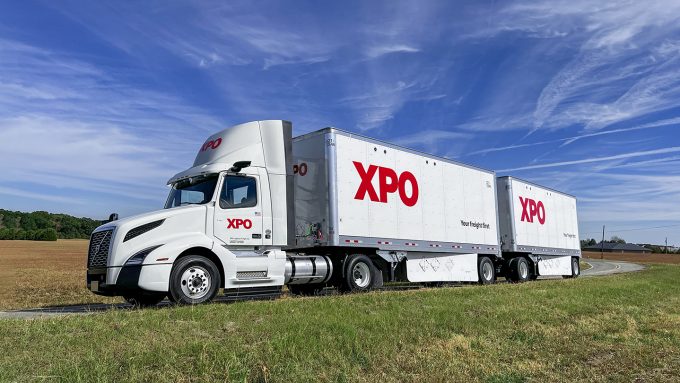Whopping $50bn FedEx Freight? Or?
Running the numbers
TFII: SOLID AS USUALMAERSK: WEAKENINGF: FALLING OFF A CLIFFAAPL: 'BOTTLENECK IN MAINLAND CHINA'AAPL: CHINA TRENDSDHL: GROWTH CAPEXR: ANOTHER SOLID DELIVERYMFT: HERE COMES THE FALLDSV: LOOK AT SCHENKER PERFORMANCEUPS: A WAVE OF DOWNGRADES DSV: BARGAIN BINKNX: EARNINGS OUTODFL: RISING AND FALLING AND THEN RISING
TFII: SOLID AS USUALMAERSK: WEAKENINGF: FALLING OFF A CLIFFAAPL: 'BOTTLENECK IN MAINLAND CHINA'AAPL: CHINA TRENDSDHL: GROWTH CAPEXR: ANOTHER SOLID DELIVERYMFT: HERE COMES THE FALLDSV: LOOK AT SCHENKER PERFORMANCEUPS: A WAVE OF DOWNGRADES DSV: BARGAIN BINKNX: EARNINGS OUTODFL: RISING AND FALLING AND THEN RISING

As job culls spill over into the less-than-truckload (LTL) sector, XPO has been on a trimming mission that aims to generate annual savings of more than $50m in labour costs.
Other LTL firms have reduced their investment plans for the year in response to uncertainty when the market will see a recovery.
According to chief strategy officer Ali Faghri, XPO’s head count shrank about 1% from Q4 22 to the first quarter of this year, with a bigger reduction in the current quarter and further redundancies to come through attrition.
“We expect to see the full run rate benefit of those cost savings starting in the third quarter,” explained a spokesperson. “As a result of these actions, headcount will take a step down through the rest of the year, primarily through attrition.”
CEO Mario Harik, in an earnings call with analysts, said: “We’re executing on a plan to align our field cost structure more closely with the current demand environment.”
The US LTL sector rolled through the downturn of 2022 relatively unscathed, compared to the sharp contraction in the truckload market, but it is battling a soft market not showing any signs of improving, the latest Market Update & Outlook, produced by Uber Freight, shows.
Most of the large LTL carriers reported contraction in their business – Yellow and Old Dominion both saw daily tonnage drop nearly 12% in the first quarter.
Yellow CEO Darren Hawkins and Old Dominion CEO Greg Gantt said the soft demand environment was a continuation of the weakness seen towards the end of 2022, with the typical seasonal demand uptick in the second half of the quarter failing to materialise this year.
The slower market has taken a toll on LTL carriers’ balance sheets. Yellow’s LTL revenue dropped 7.4%, and its net result slumped to a $54.6m deficit – almost double the loss of $27.5m tabled a year earlier. Saia’s net was down from $79.4m in Q1 22 to $76.9m. ArcBest, parent of ABF Freight System, reported a 2.4% rise in profit to $71.3m, but that was largely attributed to the sale of the maintenance division, FleetNet America. Revenue per shipment dropped 8.5% in the quarter.
XPO’s Q1 revenue inched up, from $1.89bn to $1.91bn. Net income, though, dropped to $17m from $32m a year ago. However, LTL business, its biggest segment, shows a 1.2% gain in revenue to $1.12bn.
Thanks to the limited number of players and high entry threshold, carriers have continued to show pricing discipline, but it has softened, Uber Freight noted. In the main, this is playing out in the competition for new business, where carriers have become more aggressive.
Meanwhile, expectations of market recovery have given way to uncertainty. Uber Freight noted that the PMI has remained stuck in contraction, which augurs a decline in volumes ahead.
“In the near term, demand continues to be relatively flat, due in part to ongoing destocking,” said Mr Hawkins.
The outlook is prompting some LTL firms to scale back investment plans for this year. Old Dominion has shaved $100m off its $800m capital expenditure plan and TFI has trimmed $50m to $200m-$225m.
FedEx Freight and Yellow are also planning to reduce their terminal footprint. The former intends to close 29 locations in its network, while Yellow wants to lose 28 of its smaller terminals.
Others are still in expansion gear. ArcBest confirmed it was going ahead with its plan to spend $300m to $325m, while Knight-Swift has signalled that it is proceeding with plans to add 11 terminals to its network.
Comment on this article